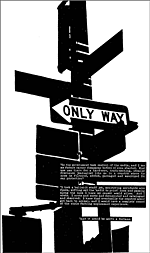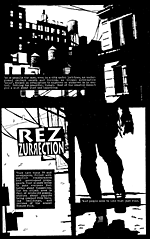>> Comment: Appointments With Disappointment
>> Comment: Accentuate The Positive?
More...

 Writer/Artist: Brian Wood
Writer/Artist: Brian Wood
Collecting CHANNEL ZERO #1-5
Price: $12.95
Publisher: Ait/PlanetLar
ISBN: 0-9676847-4-9
Science fiction has always been about today via yesterday. It's the future looking back at the present. It's a lesson for today by those who've experienced it, because we wouldn't believe anybody else. A lot of science fiction writers get caught up in the trappings of the genre, rather than embracing the genre itself. But not CHANNEL ZERO, and not Brian Wood.
CHANNEL ZERO is today. It's the present minus the ineptitude and subtlety of societal movers and shakers. America has become an isolationist dictatorship. The Concerned Mothers Of America and the Bible Belt have nothing on the religious zealots and special interest groups of Wood's near-future setting. Forced to pass the Clean Act, the government now considers freedom of speech a luxury. In a world where America is becoming ever more dangerous to those outside, freedom to impart knowledge suddenly becomes the most important right.
Into this world steps Jennie 2.5, a young woman with a passion. She's been seen with all the right people, supported all the right causes, and now she's at the forefront of a terrorist action against the banality of Christian TV and capitalist shilling. She begins with fairly tame intrusions into the TV network, but soon becomes an international heroine and America's Most Wanted. Why does she do it? To say what isn't being said? To inspire others? Or is there some less altruistic motive at the core of her actions?
Originally published in black and white by Image, Wood's masterpiece sold poorly to a small but loyal audience. One of those people was Larry Young, a man who, as the publisher behind AiT/PlanetLar, would find himself in a position to do something about it. Collected together with additional material, the CHANNEL ZERO graphic novel was born, and found a far more receptive audience. Since then it has won numerous awards and brought Wood's name out into the open.
 What strikes the casual reader more than anything is the combination of corporate design sheen and ink-punk fanzine energy. It's this synergy between the capitalist world and the "info-terrorist" that infuses this work from the first page to the last. Even the introductions play to this; one from super-hero innovator and mainstream showstopper Warren Ellis, and the other from 'zine producer, fine-artist and self-publisher Dave Choe.
What strikes the casual reader more than anything is the combination of corporate design sheen and ink-punk fanzine energy. It's this synergy between the capitalist world and the "info-terrorist" that infuses this work from the first page to the last. Even the introductions play to this; one from super-hero innovator and mainstream showstopper Warren Ellis, and the other from 'zine producer, fine-artist and self-publisher Dave Choe.
The artwork itself is abstract black and white, seemingly designed with photocopying in mind. But however abstract the lines get, it's never difficult to tell what's being represented. In fact, the work seems at its best when moving away from the figurative comic-book realism of some of the panels. Wood's obvious skill at design overshadows his slightly less precise classical figure work. Indeed, the work loses its charm the closer it gets to the familiar comic tropes of panels and speech-balloons.
With so much attention cast upon the artwork of this collection, it's often forgotten that Wood is as deft with his words as he is with his lines. CHANNEL ZERO is not a story, it is a documentary. A dispassionate third-person view of an individual's rise and fall within the media spotlight. It even has ad breaks - or subvertisements, as they're called here. Cut-out-and-copy cries for help that are ambivalently intended. Are they adverts for this comic or anti-capitalist slogans? Are they intended as fictional or real-world slogans?
It's the separation from the actions of CHANNEL ZERO'S lead that allows us to see her not as she would like to be seen, but as she really is. An attention seeker. An instinctive individual, whose ideas are not always fully considered. A woman with a black-and-white distinction of life. The fascinating glimpses into her psyche through other people, through interviews, through her own thoughts, all portray the same woman in different ways. Jennie 2.5 is a unique creation.
 The arc of the character - as it's a character piece more than a plot-based narrative - mimics our own understanding of her intentions. It's with the final chapter that we realise - just as she realises - how flawed her actions have been. Ultimately, this is not simply an underdog-versus-corporate America tale, filled with anti-capitalist spiel and hatred of authority. This is about one woman who tries to break something, but is ultimately broken upon it. This is about one woman who discovers that whichever side you're on, there will always be the same problems.
The arc of the character - as it's a character piece more than a plot-based narrative - mimics our own understanding of her intentions. It's with the final chapter that we realise - just as she realises - how flawed her actions have been. Ultimately, this is not simply an underdog-versus-corporate America tale, filled with anti-capitalist spiel and hatred of authority. This is about one woman who tries to break something, but is ultimately broken upon it. This is about one woman who discovers that whichever side you're on, there will always be the same problems.
The ingenuity of each episode serves to heighten the arc. The hidden subliminal messages begin quite tamely and then increase in volume, building to a climax. Furthering the fourth-wall indistinction, we are left to ponder who the graffiti artist is; Brian Wood or Jennie 2.5? The less subtle juxtaposition of the real news with America's propaganda leads us up to a fourth chapter where Jennie, trapped between the cameras of the media and the guns of the military, sinks into the background.
The book's final chapter is the stand-alone story of a cleaner at work. Each page is a splash page evoking Frank Miller's genre redefining SIN CITY tale "Silent Night". Even in this short arc, Wood can't give up the urge to place character at the fore. It's at this point that his linework is at its creative peak, pared down to single images with a singular purpose. It's also here that Wood comes closest overcoming the limitations of the sequential artform. Wood's artwork is at it's best when pushing architecture around the page. He knows the real New York, the one that may not be present in any photograph, but lives inside New Yorkers' heads.
More than anything, CHANNEL ZERO is Wood discovering how his design skills can be put to work for a comic. Along with the accompanying design book, PUBLIC DOMAIN (AiT/PlanetLar, $12.95), it sets out to open up a fascinating new branch of sequential art. If only there were more artists out there dealing with this kind of innovation, it could really lead somewhere interesting. But outside of abstract painters like David Mack (KABUKI) or Ashley Wood (POPBOT), it's still virgin territory. Brian Wood's since proved he can do plot-based arcs for such publishers as Oni and Marvel, but it's in the character work that he excels. And CHANNEL ZERO has yet to be bettered, by Wood or by anybody else.

This article is Ideological Freeware. The author grants permission for its reproduction and redistribution by private individuals on condition that the author and source of the article are clearly shown, no charge is made, and the whole article is reproduced intact, including this notice.


